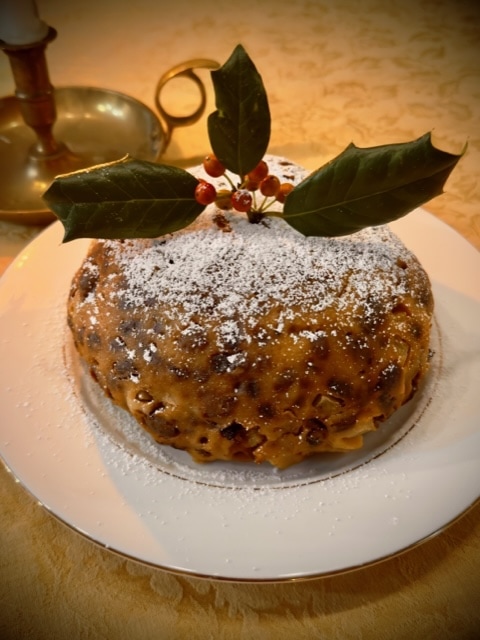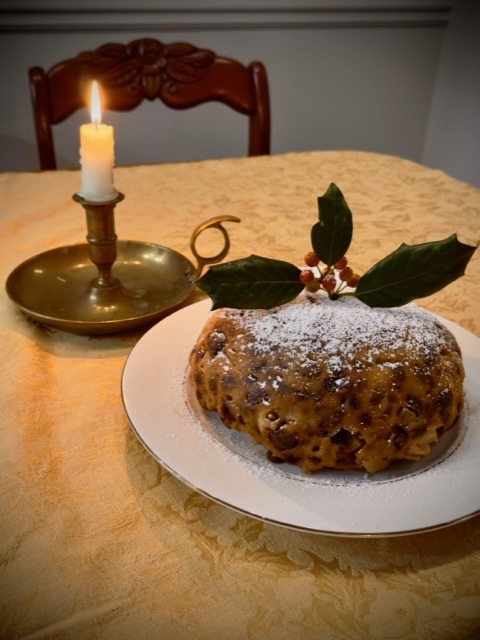
Now bring me some figgy pudding! The old, albeit quite bossy, line from an old Christmas carol reminds us what an integral part of a Christmas meal this famous dessert truly is. So popular that the people demand it! This dessert was made world famous in Charles Dickens’ 1843 masterpiece, A Christmas Carol. This dessert has many names: Christmas Pudding, Figgy Pudding, Plum Pudding, Plum Porridge, and Plum Pottage. In actuality, the Christmas puddings of today and Victorian Britain contain plums or figs. Plums referred to any dried fruit in the Victorian Era. It is quite possible that Christmas Pudding once contained dried figs, but the modern version uses raisins and dried currants. While making this dessert, families took turns stirring the pudding, each making a wish while doing so. This traditional British dessert was once baked with a silver sixpence inside. The family member who found the coin would have good fortune in the following year. While a very charming tradition, it sounds dangerous to my modern ears.
While I strive for authenticity, especially when recreating very traditional dishes from other countries, some of these ingredients are difficult to track down. Suet, or beef fat found along the kidney, is a traditional British ingredient that sounds simple enough but can be tricky to find. If you don’t want to order it online, butter or shortening will make a decent substitute. Another ingredient we don’t often see in American supermarkets needed for this dessert is dried currants. Currants thrive in Northern Europe and are notably popular in England, Ireland, France and Denmark. Dried currants can be found in American markets but of course can be found online as well. If you have trouble finding them, you may substitute for more raisins, dried cranberries, dried figs or prunes. Just remember that the more substitutes you use, the farther you get from the original flavor.
Today in Great Britain, Christmas Pudding is made in a more modern fashion, using a pudding bowl covered in parchment, foil and steamed. In Charles Dickens’ era, these desserts were boiled for several hours in a cloth. Many cooks used a copper laundry kettle to accommodate the large Christmas pudding. They simply mixed the ingredients together, floured a clean tea towel, added the mixture, tied it with a string and literally boiled it for hours. It took on a round shape; some compared it to a cannonball. I found one (very large) recipe from 1909 that suggested boiling the pudding for 14 hours! Today, I am going with the old-fashioned method of boiling in the towel, but with my smaller recipe, it only takes 3 1/2 hours to boil. In comparison to 14 hours, nearly 4 hours of cook time doesn’t sound so bad…but, hey, this is Christmas! Many Victorian families made these puddings days or weeks in advance in preparation for Christmas feasts. Many believed this aging added flavor. I veered from tradition here and opted to serve it right away. Today, this dessert is often served with hard sauce, a mix of butter, brandy and sugar. I adapted this recipe from Eliza Acton’s 1845 cookbook, which makes no mention of the sauce. Another traditional topping is flaming brandy, which can be quite impressive. If you prefer to keep your eyebrows un-singed, you could opt for a flurry of powdered sugar and a holly leaf on top.

Christmas Pudding (Adapted from Eliza Acton’s 1845 Cookbook-Serves 4-6)
Ingredients:
3/4 cups all purpose flour
3/4 cups breadcrumbs
3 ounces suet grated (or grated butter or shortening)
1 1/2 cups raisins
1 1/2 cups dried currants
1 cup minced fresh apples
3/4 cup sugar
1/2 cup candied orange peel (minced)
1/2 teaspoon spice (nutmeg, mace, cinnamon)
Small pinch of salt
1 small wine glass of brandy (2-ounce shot glass)
3 eggs
Instructions:
1.Mix filling together. Take a clean tea towel and flour it well. Add the pudding mixture and tie with kitchen string.
2. Take a large pot more than halfway filled with water. Bring to a boil. Add the pudding. Cover with a lid and simmer over medium-high heat for 3 1/2 hours. You will need to occasionally add more water and check often.
3. Remove the pudding with tongs. Allow to cool.
4. Remove the towel and place pudding on a plate. Top with powdered sugar, hard sauce and/or holly sprig.


